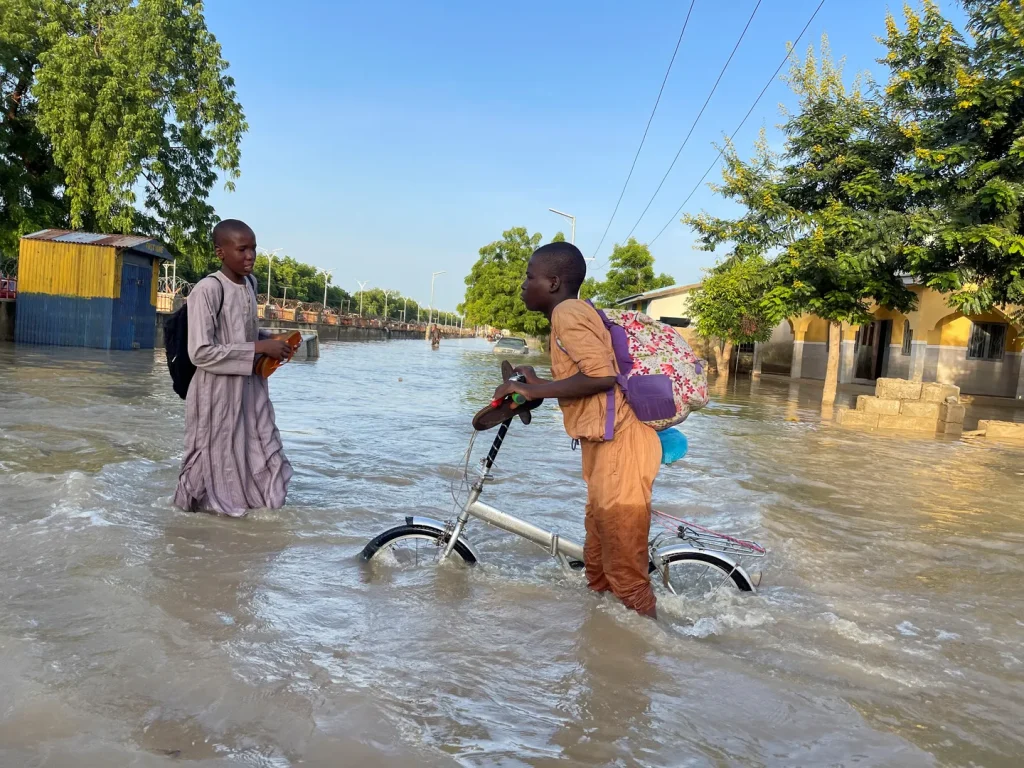Death toll rises in Nigeria as government fails to contain floods

Nigeria is drowning as floods continue to ravage the country this monsoon. With deaths mounting, critics say failed governance is at the root of the destruction.
According to the EU funded Deutsche Welle, the floods, which began on July 27th, have killed at least 23 people and swallowed up the homes of 5,560. The death toll is rising; since the rains returned in May, over 200 people have died in flood-related incidents, which experts say are preventable.
On July 29th, the UN humanitarian agency (OCHA) added that 11 additional people have been reported missing.
Heavy rains and subsequent flooding are yearly problems in Nigeria. In 2024, more than 300 people were killed and over a million displaced in at least 34 out of the country’s 36 states, making it one of Nigeria’s worst flood seasons in decades, says OCHA.
While the National Emergency Management Agency (NEMA), a government agency, claimed that “the presence of both governmental and non-governmental partners has been significant, contributing to the effective management of the humanitarian situation,” and emphasized that a shelter has been set up at Aliyu Musdafa College in Yola for those displaced, critics have argued that the state-level response has fallen flat.
Philip Jakpor, the Executive Director of the Renevlyn Development Initiative, agencies like NEMA often ignore early flood warnings and only act post-disaster. “NEMA is more reactive than proactive,” he noted, despite being given early warnings.
As early as February 2025, for instance, the Nigerian Meteorological Agency (NiMet) warned of heightened rainfall this July and identified 21 states across Nigeria at increased risk.
Yet critical infrastructure has long been in a state of disrepair. When the Governor of Adamawa State, Ahmadu Fintiri, visited a temporary displacement camp located at Yelwa Primary School on July 28th to discuss the flood, he stressed blocked water channels and emphasized the need for better drainage systems.
According to The Journal Nigeria, a trader in Owo whose shop was submerged in a flash flood earlier in July lamented: “The rain wasn’t the problem, it’s the blocked gutters, the silted rivers, the roads they (the government) never finished… We warned them last year. Nothing was done.”
On the 7th of July, NiMet issued another alert, warning that the aforementioned 21 states, including Adamawa, were at high risk of flooding. They urged residents to relocate, clear blocked drainage pipes, prepare emergency kits, and switch off power and gas during heavy rain.
The meteorologists implored “residents in flood-prone areas… to take preventive measures to reduce exposure to exposure.”
But for millions of low-income Nigerians, this is easier said than done.
Despite the forecasts and yearly trend, the government has neglected precautionary measures like strengthening infrastructure. The Journal Nigeria cites a joint investigation by SaharaReporters and BudgIT, which reveals that less than 15% of environmental protection funds allocated to flood-prone states were used for their intended purpose in 2024.
Many drainage and erosion control projects were either abandoned or never began in the first place, while emergency shelter plans also remain unexecuted.
Between September 2023 and July 2024, Kogi State received approximately ₦1.3 billion in ecological funds, but only ₦8.6 million was actually spent on flood and erosion control
This negligence has far-reaching implications. Besides the mounting death toll and widespread homelessness, a 2024 report by the World Bank and UNICEF estimates that more than 900,000 children were impacted by the floods that year. With their schools destroyed in the deluge and their families displaced, such consequences only exacerbate the country’s educational crisis.
Deutsche Welle/ OCHA/ NiMet/ The Journal Nigeria/ Maghrebi
Want to chase the pulse of North Africa?
Subscribe to receive our FREE weekly PDF magazine














